Business Law: Analyzing the English Legal System and its Impact.
VerifiedAdded on 2024/04/25
|25
|5299
|202
Report
AI Summary
This report provides a detailed analysis of Business Law within the context of the English Legal System, covering its structure, sources of law, and the role of government in law-making. It examines the impact of statutory and common law on business organizations, focusing on employers’ legal obligations regarding occupational health and safety, workers' compensation, and harassment. The report also suggests appropriate legal solutions for various business problems, justifying these solutions with relevant statutes and case law. Furthermore, it evaluates the effectiveness of the legal system in light of recent reforms and developments, comparing legal solutions with alternative legal advice, including Alternative Dispute Resolution methods. The analysis extends to a critical review of the English legal system, supported by relevant examples, and a comparison of different recommendations for legal solutions, offering a comprehensive understanding of Business Law in the UK.
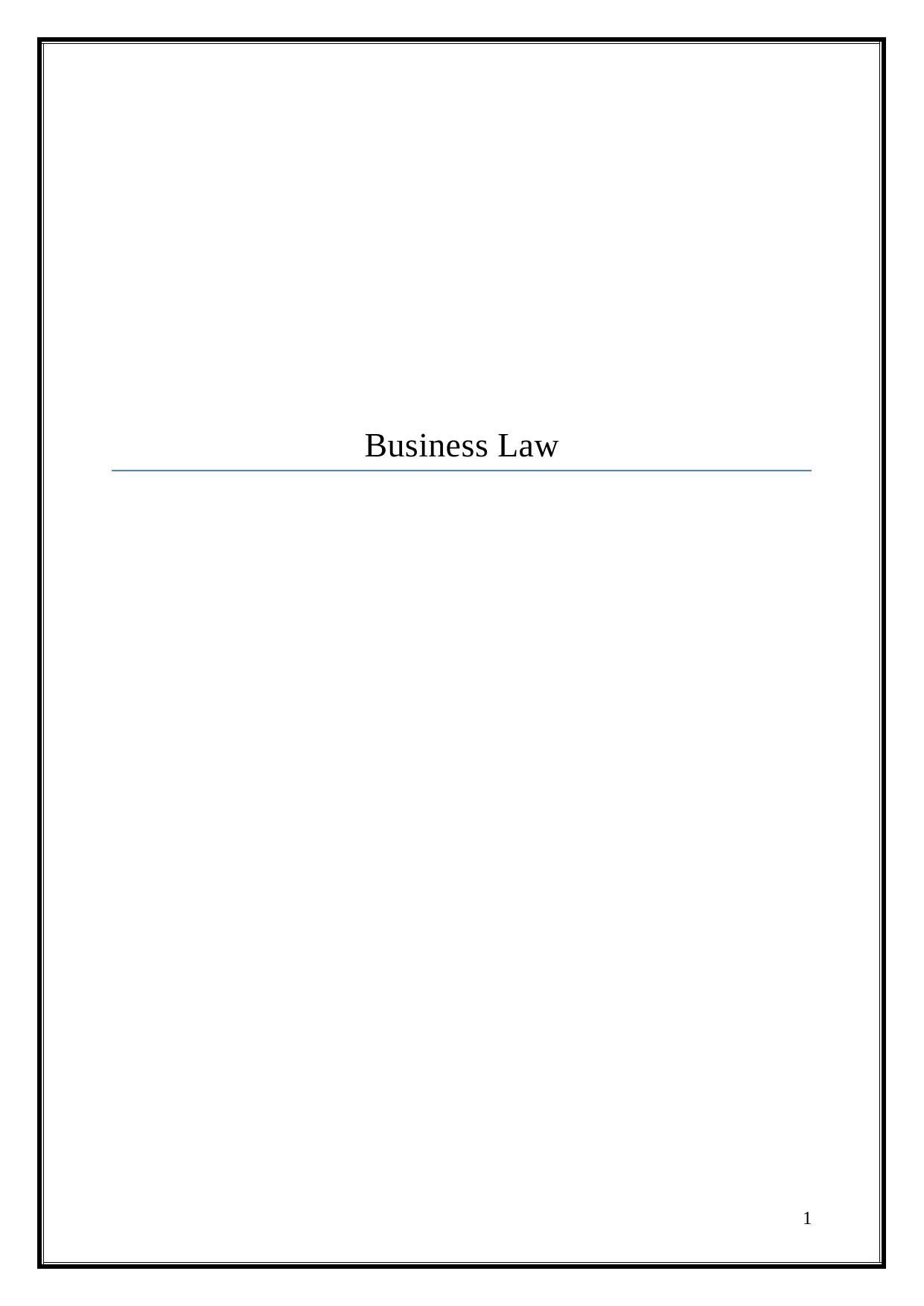
Business Law
1
1
Paraphrase This Document
Need a fresh take? Get an instant paraphrase of this document with our AI Paraphraser
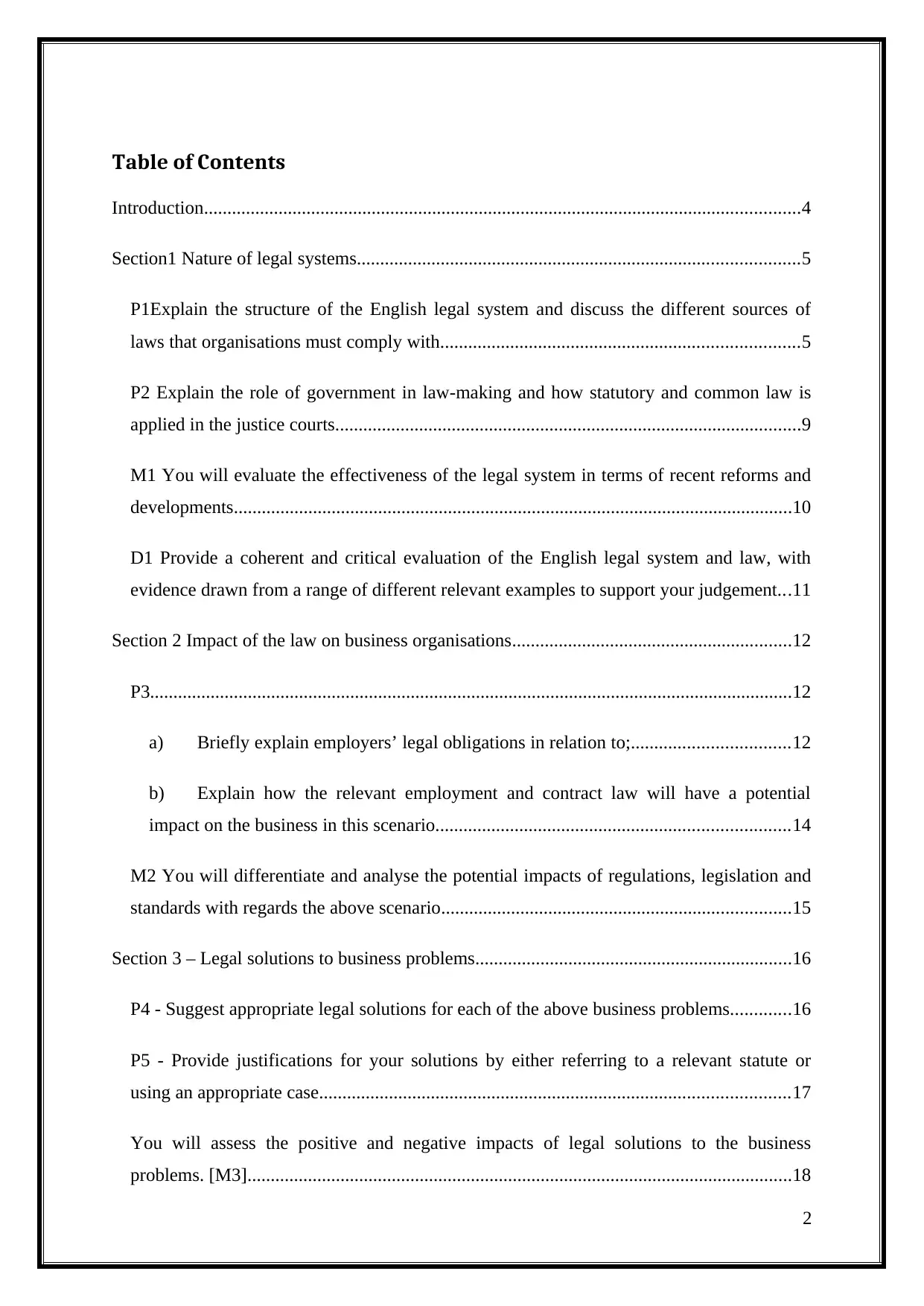
Table of Contents
Introduction................................................................................................................................4
Section1 Nature of legal systems...............................................................................................5
P1Explain the structure of the English legal system and discuss the different sources of
laws that organisations must comply with.............................................................................5
P2 Explain the role of government in law-making and how statutory and common law is
applied in the justice courts....................................................................................................9
M1 You will evaluate the effectiveness of the legal system in terms of recent reforms and
developments........................................................................................................................10
D1 Provide a coherent and critical evaluation of the English legal system and law, with
evidence drawn from a range of different relevant examples to support your judgement...11
Section 2 Impact of the law on business organisations............................................................12
P3..........................................................................................................................................12
a) Briefly explain employers’ legal obligations in relation to;..................................12
b) Explain how the relevant employment and contract law will have a potential
impact on the business in this scenario............................................................................14
M2 You will differentiate and analyse the potential impacts of regulations, legislation and
standards with regards the above scenario...........................................................................15
Section 3 – Legal solutions to business problems....................................................................16
P4 - Suggest appropriate legal solutions for each of the above business problems.............16
P5 - Provide justifications for your solutions by either referring to a relevant statute or
using an appropriate case.....................................................................................................17
You will assess the positive and negative impacts of legal solutions to the business
problems. [M3].....................................................................................................................18
2
Introduction................................................................................................................................4
Section1 Nature of legal systems...............................................................................................5
P1Explain the structure of the English legal system and discuss the different sources of
laws that organisations must comply with.............................................................................5
P2 Explain the role of government in law-making and how statutory and common law is
applied in the justice courts....................................................................................................9
M1 You will evaluate the effectiveness of the legal system in terms of recent reforms and
developments........................................................................................................................10
D1 Provide a coherent and critical evaluation of the English legal system and law, with
evidence drawn from a range of different relevant examples to support your judgement...11
Section 2 Impact of the law on business organisations............................................................12
P3..........................................................................................................................................12
a) Briefly explain employers’ legal obligations in relation to;..................................12
b) Explain how the relevant employment and contract law will have a potential
impact on the business in this scenario............................................................................14
M2 You will differentiate and analyse the potential impacts of regulations, legislation and
standards with regards the above scenario...........................................................................15
Section 3 – Legal solutions to business problems....................................................................16
P4 - Suggest appropriate legal solutions for each of the above business problems.............16
P5 - Provide justifications for your solutions by either referring to a relevant statute or
using an appropriate case.....................................................................................................17
You will assess the positive and negative impacts of legal solutions to the business
problems. [M3].....................................................................................................................18
2

You will critically review and evaluate the use of appropriate legal solutions in comparison
with alternative legal advice. [D2].......................................................................................19
Section 4 Recommending appropriate legal solutions based upon alternative legal advice....20
a): Explain the concept and benefits of using Alternative Dispute Resolution process.......20
b): Recommend alternative legal solutions to the following business problem. You can
consider another country’s legal system or a different legal framework.............................21
M4: Compare and contrast the effectiveness of two different recommendations................22
D2: Critically review and evaluate the use of appropriate legal solutions in comparison
with alternative legal advice.................................................................................................23
Conclusion................................................................................................................................24
References................................................................................................................................25
3
with alternative legal advice. [D2].......................................................................................19
Section 4 Recommending appropriate legal solutions based upon alternative legal advice....20
a): Explain the concept and benefits of using Alternative Dispute Resolution process.......20
b): Recommend alternative legal solutions to the following business problem. You can
consider another country’s legal system or a different legal framework.............................21
M4: Compare and contrast the effectiveness of two different recommendations................22
D2: Critically review and evaluate the use of appropriate legal solutions in comparison
with alternative legal advice.................................................................................................23
Conclusion................................................................................................................................24
References................................................................................................................................25
3
⊘ This is a preview!⊘
Do you want full access?
Subscribe today to unlock all pages.

Trusted by 1+ million students worldwide
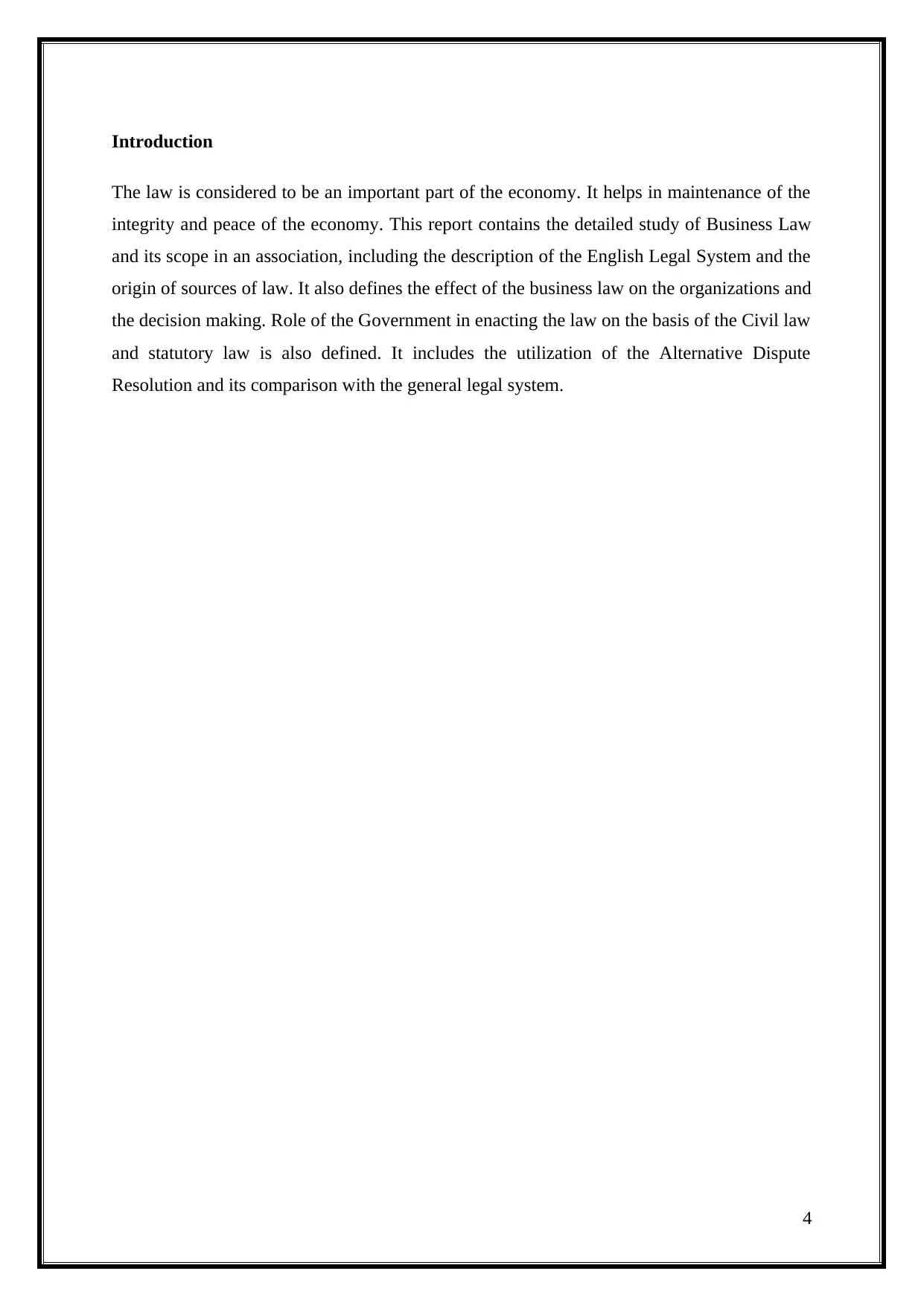
Introduction
The law is considered to be an important part of the economy. It helps in maintenance of the
integrity and peace of the economy. This report contains the detailed study of Business Law
and its scope in an association, including the description of the English Legal System and the
origin of sources of law. It also defines the effect of the business law on the organizations and
the decision making. Role of the Government in enacting the law on the basis of the Civil law
and statutory law is also defined. It includes the utilization of the Alternative Dispute
Resolution and its comparison with the general legal system.
4
The law is considered to be an important part of the economy. It helps in maintenance of the
integrity and peace of the economy. This report contains the detailed study of Business Law
and its scope in an association, including the description of the English Legal System and the
origin of sources of law. It also defines the effect of the business law on the organizations and
the decision making. Role of the Government in enacting the law on the basis of the Civil law
and statutory law is also defined. It includes the utilization of the Alternative Dispute
Resolution and its comparison with the general legal system.
4
Paraphrase This Document
Need a fresh take? Get an instant paraphrase of this document with our AI Paraphraser
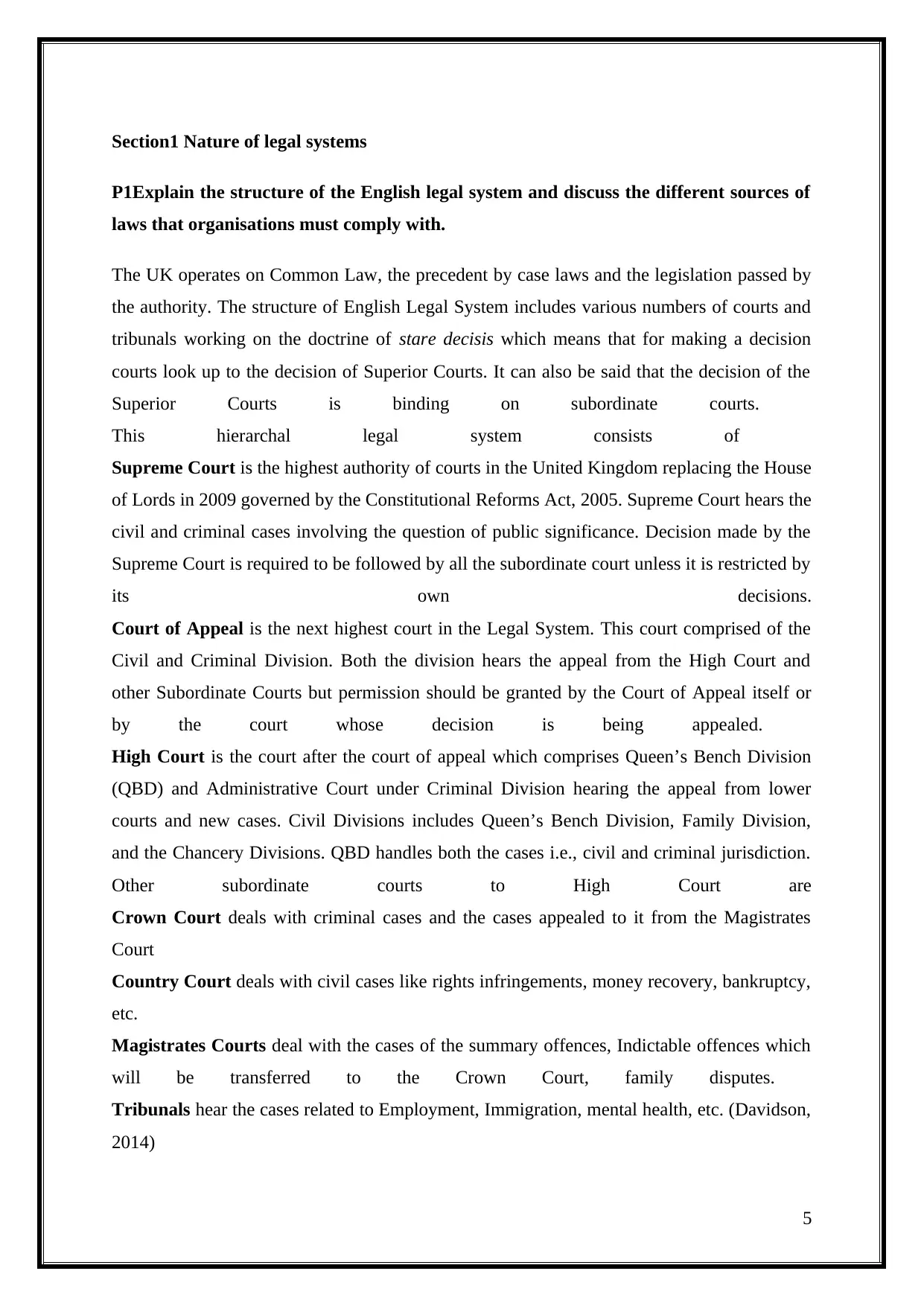
Section1 Nature of legal systems
P1Explain the structure of the English legal system and discuss the different sources of
laws that organisations must comply with.
The UK operates on Common Law, the precedent by case laws and the legislation passed by
the authority. The structure of English Legal System includes various numbers of courts and
tribunals working on the doctrine of stare decisis which means that for making a decision
courts look up to the decision of Superior Courts. It can also be said that the decision of the
Superior Courts is binding on subordinate courts.
This hierarchal legal system consists of
Supreme Court is the highest authority of courts in the United Kingdom replacing the House
of Lords in 2009 governed by the Constitutional Reforms Act, 2005. Supreme Court hears the
civil and criminal cases involving the question of public significance. Decision made by the
Supreme Court is required to be followed by all the subordinate court unless it is restricted by
its own decisions.
Court of Appeal is the next highest court in the Legal System. This court comprised of the
Civil and Criminal Division. Both the division hears the appeal from the High Court and
other Subordinate Courts but permission should be granted by the Court of Appeal itself or
by the court whose decision is being appealed.
High Court is the court after the court of appeal which comprises Queen’s Bench Division
(QBD) and Administrative Court under Criminal Division hearing the appeal from lower
courts and new cases. Civil Divisions includes Queen’s Bench Division, Family Division,
and the Chancery Divisions. QBD handles both the cases i.e., civil and criminal jurisdiction.
Other subordinate courts to High Court are
Crown Court deals with criminal cases and the cases appealed to it from the Magistrates
Court
Country Court deals with civil cases like rights infringements, money recovery, bankruptcy,
etc.
Magistrates Courts deal with the cases of the summary offences, Indictable offences which
will be transferred to the Crown Court, family disputes.
Tribunals hear the cases related to Employment, Immigration, mental health, etc. (Davidson,
2014)
5
P1Explain the structure of the English legal system and discuss the different sources of
laws that organisations must comply with.
The UK operates on Common Law, the precedent by case laws and the legislation passed by
the authority. The structure of English Legal System includes various numbers of courts and
tribunals working on the doctrine of stare decisis which means that for making a decision
courts look up to the decision of Superior Courts. It can also be said that the decision of the
Superior Courts is binding on subordinate courts.
This hierarchal legal system consists of
Supreme Court is the highest authority of courts in the United Kingdom replacing the House
of Lords in 2009 governed by the Constitutional Reforms Act, 2005. Supreme Court hears the
civil and criminal cases involving the question of public significance. Decision made by the
Supreme Court is required to be followed by all the subordinate court unless it is restricted by
its own decisions.
Court of Appeal is the next highest court in the Legal System. This court comprised of the
Civil and Criminal Division. Both the division hears the appeal from the High Court and
other Subordinate Courts but permission should be granted by the Court of Appeal itself or
by the court whose decision is being appealed.
High Court is the court after the court of appeal which comprises Queen’s Bench Division
(QBD) and Administrative Court under Criminal Division hearing the appeal from lower
courts and new cases. Civil Divisions includes Queen’s Bench Division, Family Division,
and the Chancery Divisions. QBD handles both the cases i.e., civil and criminal jurisdiction.
Other subordinate courts to High Court are
Crown Court deals with criminal cases and the cases appealed to it from the Magistrates
Court
Country Court deals with civil cases like rights infringements, money recovery, bankruptcy,
etc.
Magistrates Courts deal with the cases of the summary offences, Indictable offences which
will be transferred to the Crown Court, family disputes.
Tribunals hear the cases related to Employment, Immigration, mental health, etc. (Davidson,
2014)
5
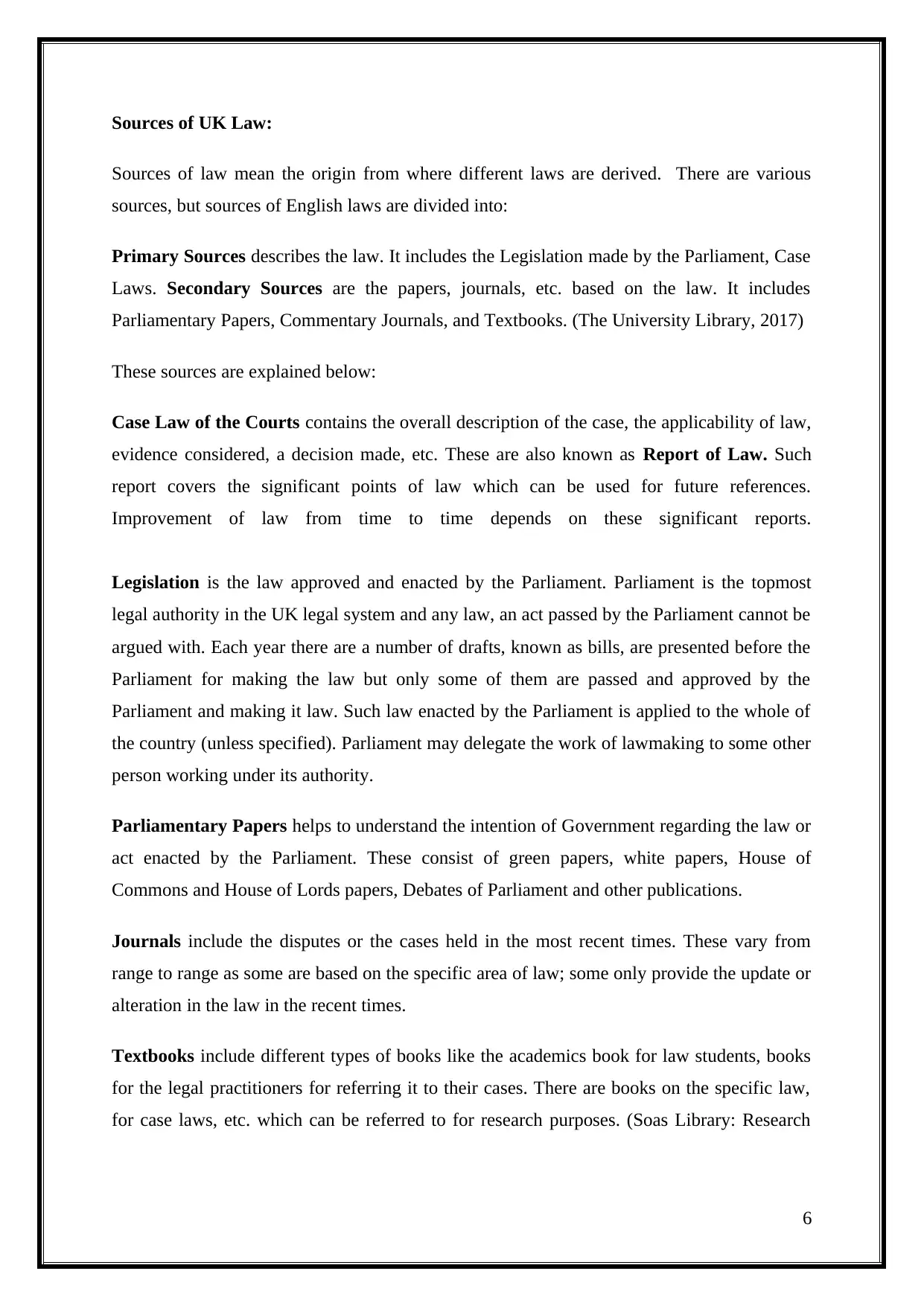
Sources of UK Law:
Sources of law mean the origin from where different laws are derived. There are various
sources, but sources of English laws are divided into:
Primary Sources describes the law. It includes the Legislation made by the Parliament, Case
Laws. Secondary Sources are the papers, journals, etc. based on the law. It includes
Parliamentary Papers, Commentary Journals, and Textbooks. (The University Library, 2017)
These sources are explained below:
Case Law of the Courts contains the overall description of the case, the applicability of law,
evidence considered, a decision made, etc. These are also known as Report of Law. Such
report covers the significant points of law which can be used for future references.
Improvement of law from time to time depends on these significant reports.
Legislation is the law approved and enacted by the Parliament. Parliament is the topmost
legal authority in the UK legal system and any law, an act passed by the Parliament cannot be
argued with. Each year there are a number of drafts, known as bills, are presented before the
Parliament for making the law but only some of them are passed and approved by the
Parliament and making it law. Such law enacted by the Parliament is applied to the whole of
the country (unless specified). Parliament may delegate the work of lawmaking to some other
person working under its authority.
Parliamentary Papers helps to understand the intention of Government regarding the law or
act enacted by the Parliament. These consist of green papers, white papers, House of
Commons and House of Lords papers, Debates of Parliament and other publications.
Journals include the disputes or the cases held in the most recent times. These vary from
range to range as some are based on the specific area of law; some only provide the update or
alteration in the law in the recent times.
Textbooks include different types of books like the academics book for law students, books
for the legal practitioners for referring it to their cases. There are books on the specific law,
for case laws, etc. which can be referred to for research purposes. (Soas Library: Research
6
Sources of law mean the origin from where different laws are derived. There are various
sources, but sources of English laws are divided into:
Primary Sources describes the law. It includes the Legislation made by the Parliament, Case
Laws. Secondary Sources are the papers, journals, etc. based on the law. It includes
Parliamentary Papers, Commentary Journals, and Textbooks. (The University Library, 2017)
These sources are explained below:
Case Law of the Courts contains the overall description of the case, the applicability of law,
evidence considered, a decision made, etc. These are also known as Report of Law. Such
report covers the significant points of law which can be used for future references.
Improvement of law from time to time depends on these significant reports.
Legislation is the law approved and enacted by the Parliament. Parliament is the topmost
legal authority in the UK legal system and any law, an act passed by the Parliament cannot be
argued with. Each year there are a number of drafts, known as bills, are presented before the
Parliament for making the law but only some of them are passed and approved by the
Parliament and making it law. Such law enacted by the Parliament is applied to the whole of
the country (unless specified). Parliament may delegate the work of lawmaking to some other
person working under its authority.
Parliamentary Papers helps to understand the intention of Government regarding the law or
act enacted by the Parliament. These consist of green papers, white papers, House of
Commons and House of Lords papers, Debates of Parliament and other publications.
Journals include the disputes or the cases held in the most recent times. These vary from
range to range as some are based on the specific area of law; some only provide the update or
alteration in the law in the recent times.
Textbooks include different types of books like the academics book for law students, books
for the legal practitioners for referring it to their cases. There are books on the specific law,
for case laws, etc. which can be referred to for research purposes. (Soas Library: Research
6
⊘ This is a preview!⊘
Do you want full access?
Subscribe today to unlock all pages.

Trusted by 1+ million students worldwide
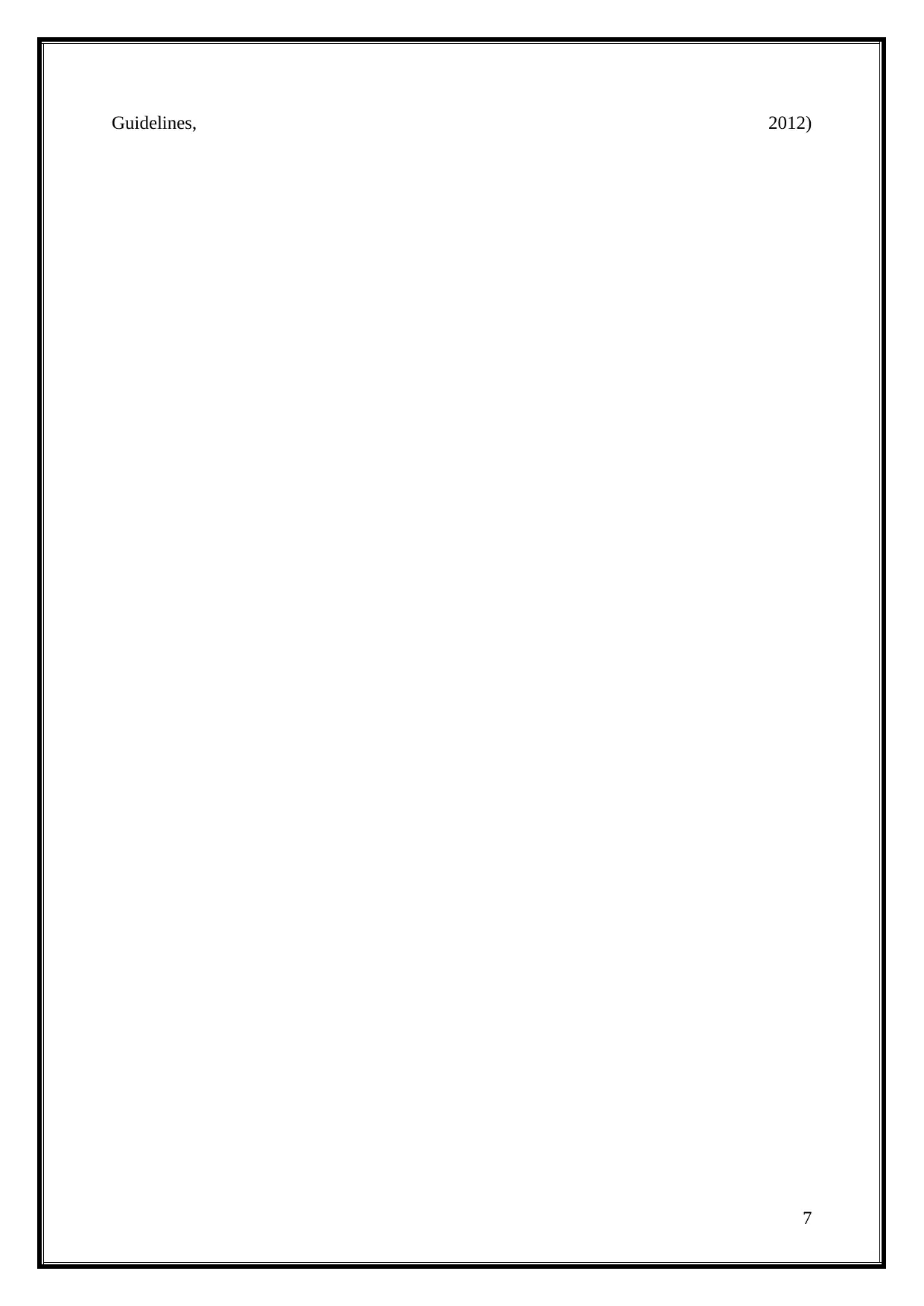
Guidelines, 2012)
7
7
Paraphrase This Document
Need a fresh take? Get an instant paraphrase of this document with our AI Paraphraser
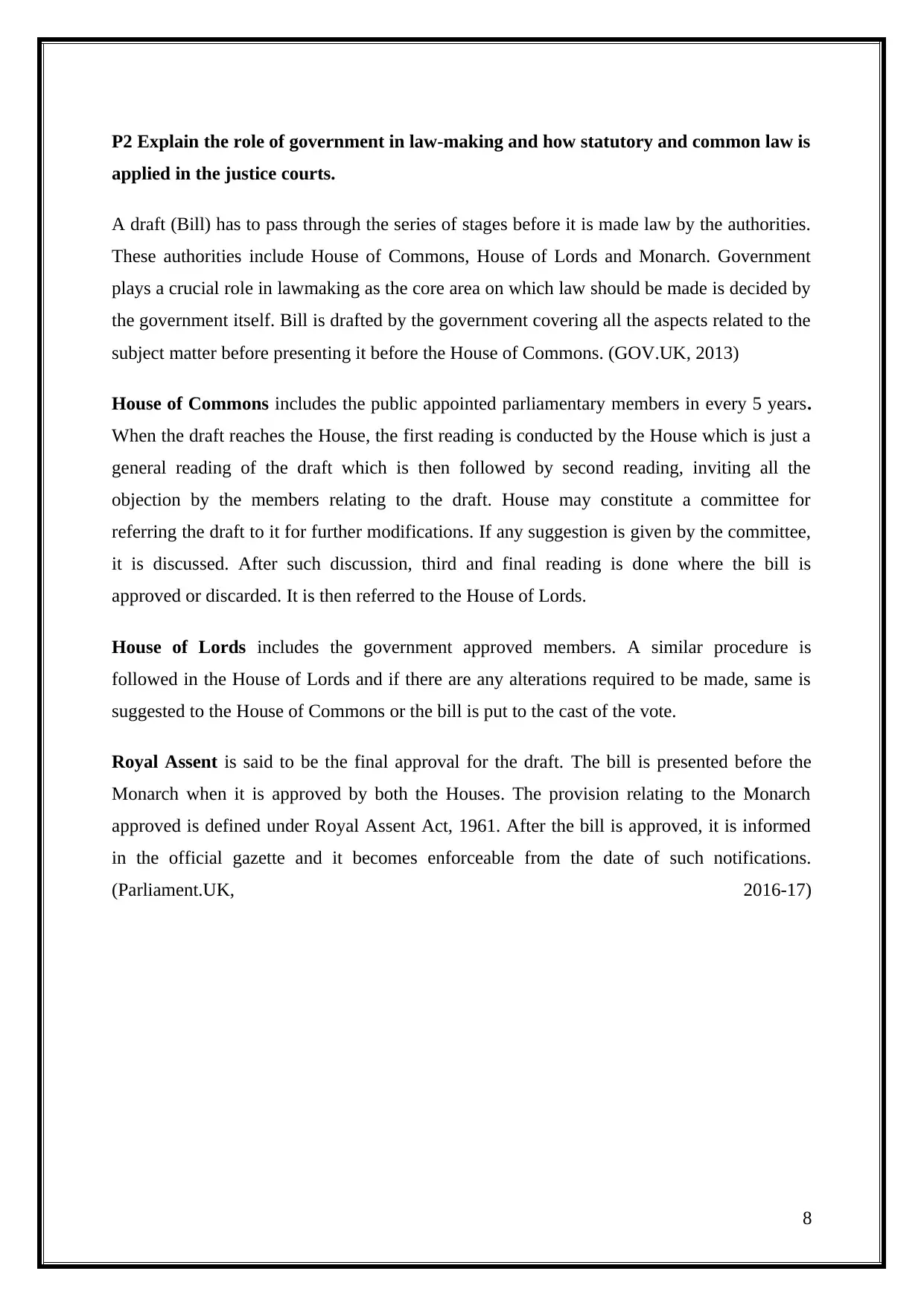
P2 Explain the role of government in law-making and how statutory and common law is
applied in the justice courts.
A draft (Bill) has to pass through the series of stages before it is made law by the authorities.
These authorities include House of Commons, House of Lords and Monarch. Government
plays a crucial role in lawmaking as the core area on which law should be made is decided by
the government itself. Bill is drafted by the government covering all the aspects related to the
subject matter before presenting it before the House of Commons. (GOV.UK, 2013)
House of Commons includes the public appointed parliamentary members in every 5 years.
When the draft reaches the House, the first reading is conducted by the House which is just a
general reading of the draft which is then followed by second reading, inviting all the
objection by the members relating to the draft. House may constitute a committee for
referring the draft to it for further modifications. If any suggestion is given by the committee,
it is discussed. After such discussion, third and final reading is done where the bill is
approved or discarded. It is then referred to the House of Lords.
House of Lords includes the government approved members. A similar procedure is
followed in the House of Lords and if there are any alterations required to be made, same is
suggested to the House of Commons or the bill is put to the cast of the vote.
Royal Assent is said to be the final approval for the draft. The bill is presented before the
Monarch when it is approved by both the Houses. The provision relating to the Monarch
approved is defined under Royal Assent Act, 1961. After the bill is approved, it is informed
in the official gazette and it becomes enforceable from the date of such notifications.
(Parliament.UK, 2016-17)
8
applied in the justice courts.
A draft (Bill) has to pass through the series of stages before it is made law by the authorities.
These authorities include House of Commons, House of Lords and Monarch. Government
plays a crucial role in lawmaking as the core area on which law should be made is decided by
the government itself. Bill is drafted by the government covering all the aspects related to the
subject matter before presenting it before the House of Commons. (GOV.UK, 2013)
House of Commons includes the public appointed parliamentary members in every 5 years.
When the draft reaches the House, the first reading is conducted by the House which is just a
general reading of the draft which is then followed by second reading, inviting all the
objection by the members relating to the draft. House may constitute a committee for
referring the draft to it for further modifications. If any suggestion is given by the committee,
it is discussed. After such discussion, third and final reading is done where the bill is
approved or discarded. It is then referred to the House of Lords.
House of Lords includes the government approved members. A similar procedure is
followed in the House of Lords and if there are any alterations required to be made, same is
suggested to the House of Commons or the bill is put to the cast of the vote.
Royal Assent is said to be the final approval for the draft. The bill is presented before the
Monarch when it is approved by both the Houses. The provision relating to the Monarch
approved is defined under Royal Assent Act, 1961. After the bill is approved, it is informed
in the official gazette and it becomes enforceable from the date of such notifications.
(Parliament.UK, 2016-17)
8
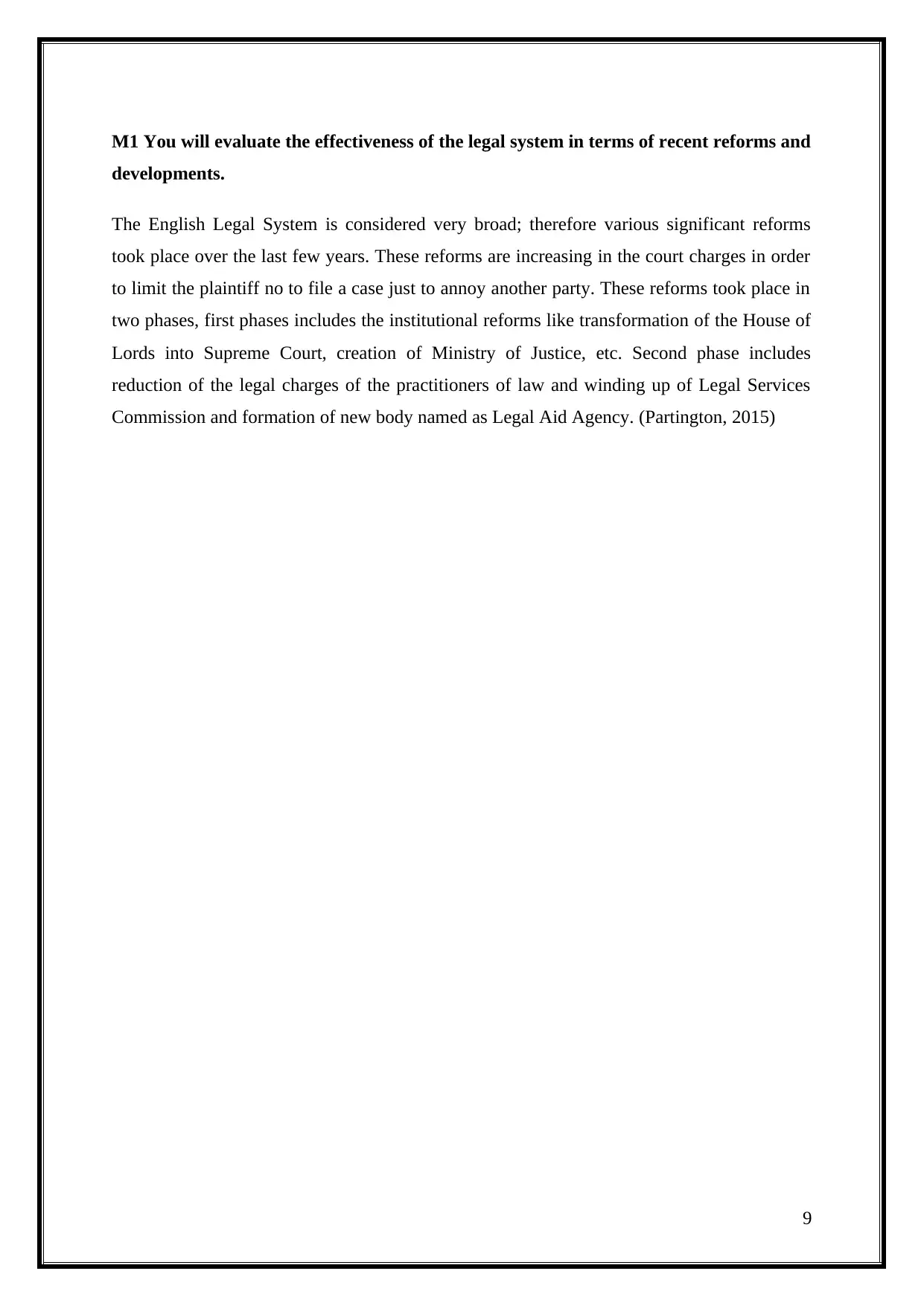
M1 You will evaluate the effectiveness of the legal system in terms of recent reforms and
developments.
The English Legal System is considered very broad; therefore various significant reforms
took place over the last few years. These reforms are increasing in the court charges in order
to limit the plaintiff no to file a case just to annoy another party. These reforms took place in
two phases, first phases includes the institutional reforms like transformation of the House of
Lords into Supreme Court, creation of Ministry of Justice, etc. Second phase includes
reduction of the legal charges of the practitioners of law and winding up of Legal Services
Commission and formation of new body named as Legal Aid Agency. (Partington, 2015)
9
developments.
The English Legal System is considered very broad; therefore various significant reforms
took place over the last few years. These reforms are increasing in the court charges in order
to limit the plaintiff no to file a case just to annoy another party. These reforms took place in
two phases, first phases includes the institutional reforms like transformation of the House of
Lords into Supreme Court, creation of Ministry of Justice, etc. Second phase includes
reduction of the legal charges of the practitioners of law and winding up of Legal Services
Commission and formation of new body named as Legal Aid Agency. (Partington, 2015)
9
⊘ This is a preview!⊘
Do you want full access?
Subscribe today to unlock all pages.

Trusted by 1+ million students worldwide
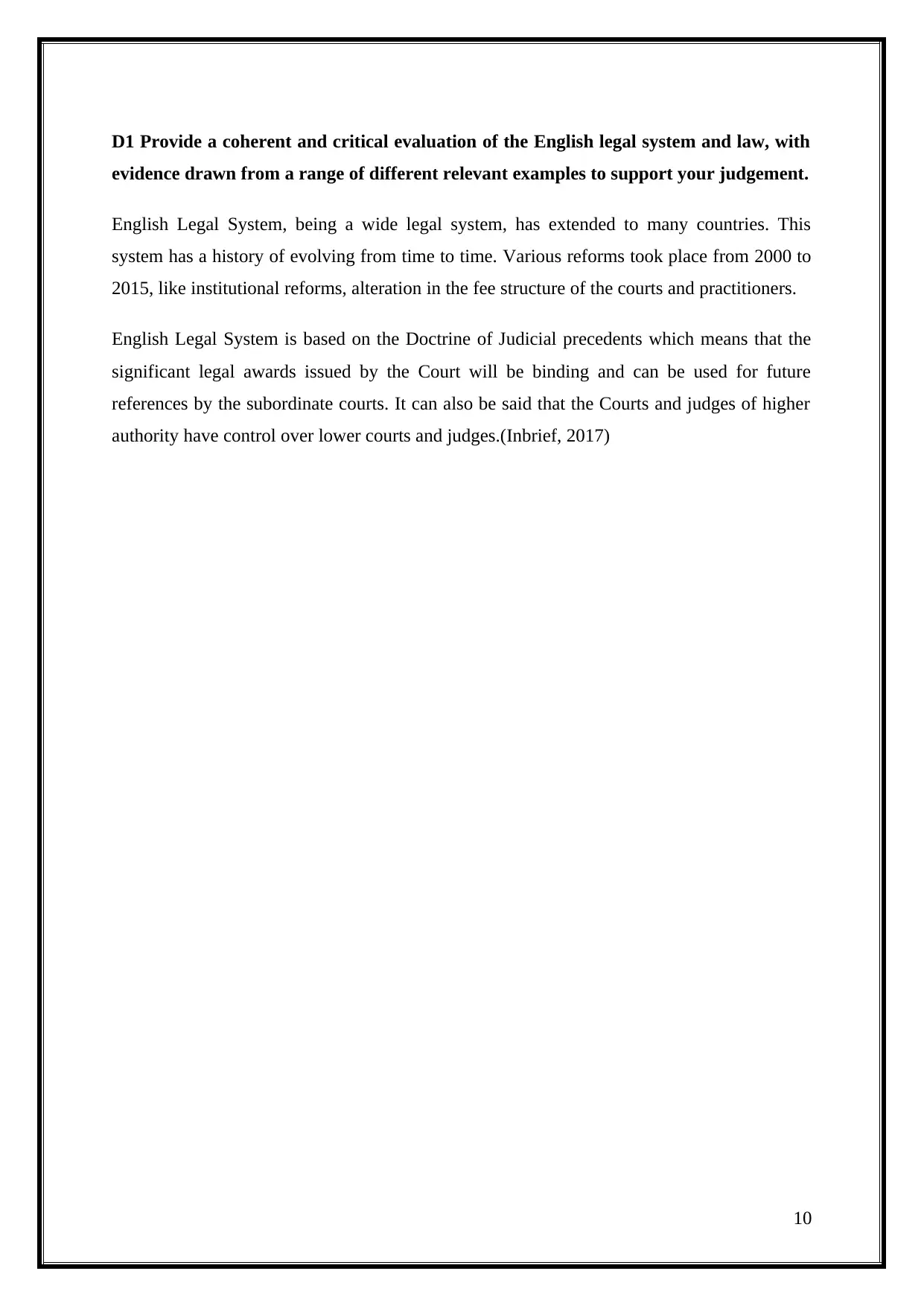
D1 Provide a coherent and critical evaluation of the English legal system and law, with
evidence drawn from a range of different relevant examples to support your judgement.
English Legal System, being a wide legal system, has extended to many countries. This
system has a history of evolving from time to time. Various reforms took place from 2000 to
2015, like institutional reforms, alteration in the fee structure of the courts and practitioners.
English Legal System is based on the Doctrine of Judicial precedents which means that the
significant legal awards issued by the Court will be binding and can be used for future
references by the subordinate courts. It can also be said that the Courts and judges of higher
authority have control over lower courts and judges.(Inbrief, 2017)
10
evidence drawn from a range of different relevant examples to support your judgement.
English Legal System, being a wide legal system, has extended to many countries. This
system has a history of evolving from time to time. Various reforms took place from 2000 to
2015, like institutional reforms, alteration in the fee structure of the courts and practitioners.
English Legal System is based on the Doctrine of Judicial precedents which means that the
significant legal awards issued by the Court will be binding and can be used for future
references by the subordinate courts. It can also be said that the Courts and judges of higher
authority have control over lower courts and judges.(Inbrief, 2017)
10
Paraphrase This Document
Need a fresh take? Get an instant paraphrase of this document with our AI Paraphraser
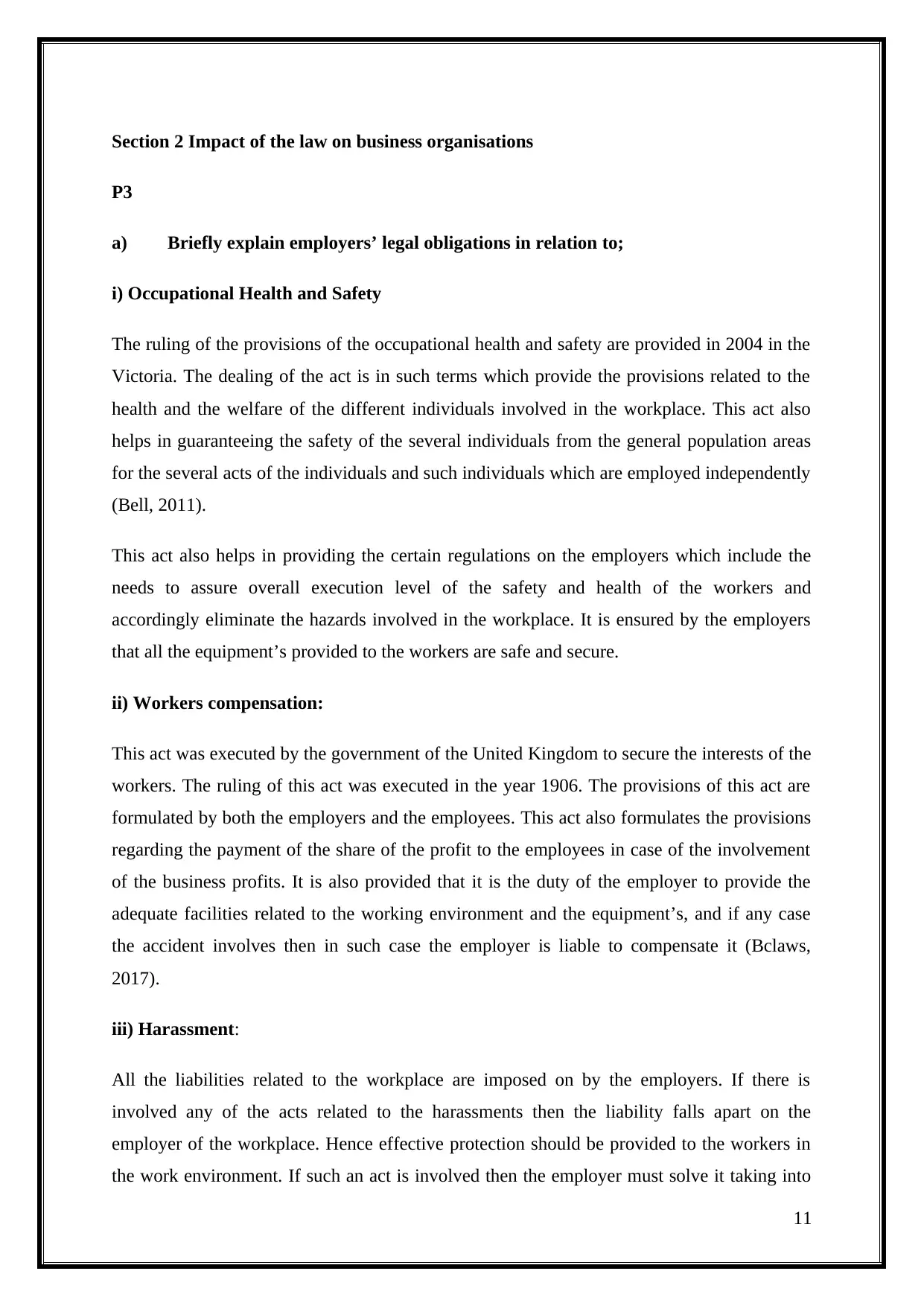
Section 2 Impact of the law on business organisations
P3
a) Briefly explain employers’ legal obligations in relation to;
i) Occupational Health and Safety
The ruling of the provisions of the occupational health and safety are provided in 2004 in the
Victoria. The dealing of the act is in such terms which provide the provisions related to the
health and the welfare of the different individuals involved in the workplace. This act also
helps in guaranteeing the safety of the several individuals from the general population areas
for the several acts of the individuals and such individuals which are employed independently
(Bell, 2011).
This act also helps in providing the certain regulations on the employers which include the
needs to assure overall execution level of the safety and health of the workers and
accordingly eliminate the hazards involved in the workplace. It is ensured by the employers
that all the equipment’s provided to the workers are safe and secure.
ii) Workers compensation:
This act was executed by the government of the United Kingdom to secure the interests of the
workers. The ruling of this act was executed in the year 1906. The provisions of this act are
formulated by both the employers and the employees. This act also formulates the provisions
regarding the payment of the share of the profit to the employees in case of the involvement
of the business profits. It is also provided that it is the duty of the employer to provide the
adequate facilities related to the working environment and the equipment’s, and if any case
the accident involves then in such case the employer is liable to compensate it (Bclaws,
2017).
iii) Harassment:
All the liabilities related to the workplace are imposed on by the employers. If there is
involved any of the acts related to the harassments then the liability falls apart on the
employer of the workplace. Hence effective protection should be provided to the workers in
the work environment. If such an act is involved then the employer must solve it taking into
11
P3
a) Briefly explain employers’ legal obligations in relation to;
i) Occupational Health and Safety
The ruling of the provisions of the occupational health and safety are provided in 2004 in the
Victoria. The dealing of the act is in such terms which provide the provisions related to the
health and the welfare of the different individuals involved in the workplace. This act also
helps in guaranteeing the safety of the several individuals from the general population areas
for the several acts of the individuals and such individuals which are employed independently
(Bell, 2011).
This act also helps in providing the certain regulations on the employers which include the
needs to assure overall execution level of the safety and health of the workers and
accordingly eliminate the hazards involved in the workplace. It is ensured by the employers
that all the equipment’s provided to the workers are safe and secure.
ii) Workers compensation:
This act was executed by the government of the United Kingdom to secure the interests of the
workers. The ruling of this act was executed in the year 1906. The provisions of this act are
formulated by both the employers and the employees. This act also formulates the provisions
regarding the payment of the share of the profit to the employees in case of the involvement
of the business profits. It is also provided that it is the duty of the employer to provide the
adequate facilities related to the working environment and the equipment’s, and if any case
the accident involves then in such case the employer is liable to compensate it (Bclaws,
2017).
iii) Harassment:
All the liabilities related to the workplace are imposed on by the employers. If there is
involved any of the acts related to the harassments then the liability falls apart on the
employer of the workplace. Hence effective protection should be provided to the workers in
the work environment. If such an act is involved then the employer must solve it taking into
11

consideration the ruling of equality act. Effective and the adequate investigation is also
required to be necessitated by the employer when there is involved any of such activities.
Effective and the adequate environment should be provided in by the employers to the
employees where they can work without any hesitations. The effective strategies should be
set by the business to eradicate the concept of provocation in the business.
iv) Equal opportunities:
The ruling related to the Equality Act 2010 is provided to the employers in terms of the
unjust treatment in relation to the race, sex, religion, etc. If there is involved the act of the
exploitation in the workplace then in such case the employer is liable for such actions. The
matter must be dealt in with the involvement of the actual evidence. The provisions of this act
helps in the development of the concept that if there is involved the activities of the
inequalities then the business should review its planning and the procedures and if these are
breached then the responsibilities are imposed on the related authorities and the liability to
impose the corrective measure is also on the employer (Emir, 2016).
12
required to be necessitated by the employer when there is involved any of such activities.
Effective and the adequate environment should be provided in by the employers to the
employees where they can work without any hesitations. The effective strategies should be
set by the business to eradicate the concept of provocation in the business.
iv) Equal opportunities:
The ruling related to the Equality Act 2010 is provided to the employers in terms of the
unjust treatment in relation to the race, sex, religion, etc. If there is involved the act of the
exploitation in the workplace then in such case the employer is liable for such actions. The
matter must be dealt in with the involvement of the actual evidence. The provisions of this act
helps in the development of the concept that if there is involved the activities of the
inequalities then the business should review its planning and the procedures and if these are
breached then the responsibilities are imposed on the related authorities and the liability to
impose the corrective measure is also on the employer (Emir, 2016).
12
⊘ This is a preview!⊘
Do you want full access?
Subscribe today to unlock all pages.

Trusted by 1+ million students worldwide
1 out of 25
Related Documents
Your All-in-One AI-Powered Toolkit for Academic Success.
+13062052269
info@desklib.com
Available 24*7 on WhatsApp / Email
![[object Object]](/_next/static/media/star-bottom.7253800d.svg)
Unlock your academic potential
Copyright © 2020–2025 A2Z Services. All Rights Reserved. Developed and managed by ZUCOL.





